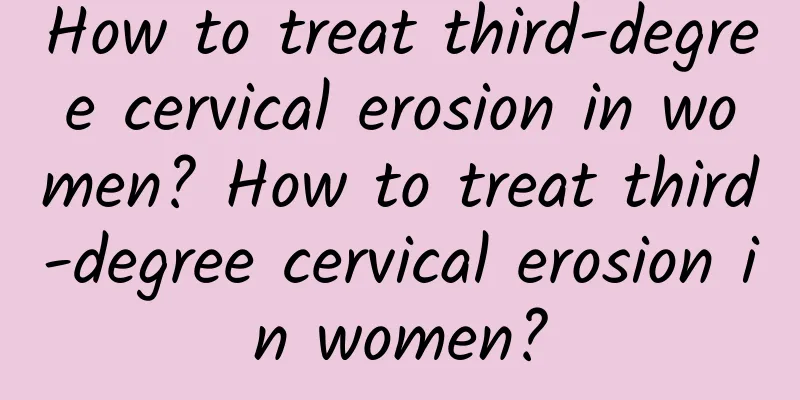How to treat third-degree cervical erosion in women? How to treat third-degree cervical erosion in women?

|
How to treat third degree cervical erosion? Cervical erosion is actually a misunderstanding of a normal cervical manifestation in the past. Now it is replaced by the physiological phenomenon of "cervical columnar epithelium ectopia" in academia. So can third degree cervical erosion be cured? Let's learn about it together today. How to treat third degree cervical erosion? Can it be cured? Cervical columnar epithelial ectopia does not require any treatment. Many current methods for treating cervical erosion are wrong. However, symptomatic cervicitis does need to be treated. Acute inflammation is treated with suppositories, and chronic inflammation can be treated with physical therapy such as laser or freezing. What is the cause of cervical erosion? There are two different types of cells in the cervix, the ones near the vagina are squamous cells, and the ones near the uterus are columnar cells. The two types of epithelial cells are different in appearance. The central part, which looks a bit like "eroded" cervix, is the appearance after being covered by columnar epithelium, while the relatively smooth outer part of the cervix is the part of the cervix covered by squamous epithelial cells. Before puberty, women's ovarian function is not perfect, estrogen is low, and the columnar epithelium is closer to the inside. After menstruation, the columnar epithelium is affected by estrogen and develops more to the outside. Therefore, more columnar epithelium similar to "erosion" is found during cervical examination. After menopause, women's estrogen levels drop, and the columnar epithelium begins to retreat to the inside. At this time, the "erosion" is no longer visible during examination. Therefore, in essence, the so-called cervical erosion is actually the eversion of the columnar epithelium. Is cervical erosion serious? The so-called first-degree, second-degree, and third-degree cervical erosion in medical textbooks in the past are easy to understand if you look at the real mechanism of "cervical erosion" mentioned above. This is actually the different degrees of eversion of the columnar epithelium after being affected by estrogen, which is a normal physiological phenomenon. Will cervical erosion develop into cancer if it is not treated? The occurrence of cervical cancer is related to infection with human papillomavirus (HpV). Some so-called high-risk types of HPV are prone to precancerous lesions and cervical cancer when they continue to infect the squamous-columnar junction of the cervix. Since the advent of cervical smears, the mortality rate of cervical cancer has dropped significantly. The key is early prevention and treatment. It is currently recommended that women over the age of 21 should undergo a cervical smear examination once a year. After the age of 30, an HPV examination can be combined. If the HPV and cervical smear tests are negative for three consecutive times, the interval can be extended to once every three years, and screening can be stopped after the age of 65. |
<<: How to diagnose cervicitis in women? Six methods to diagnose whether you have cervicitis
>>: What are the hazards of cervical erosion in women?
Recommend
Expert analysis: How women can prevent bacterial vaginosis
How can women prevent bacterial vaginitis? Gyneco...
What tests should be done to prepare for pregnancy after a missed abortion?
In order to ensure that the body returns to norma...
Several common symptoms of vaginal candidiasis
It is understood that many female friends suffer ...
Can pelvic peritonitis be cured?
Pelvic peritonitis brings great pain to women, an...
What a surprise! Don’t throw away the eggplant stems, they can lower cholesterol and blood pressure
Some ingredients are valuable all over, but it is...
What's wrong with taking emergency contraceptive pills and having periods twice a month?
What's wrong with taking emergency contracept...
A review of the causes of hyperprolactinemia
Hyperprolactinemia must be treated early to avoid...
Can pelvic effusion be treated with moxa every day?
Can pelvic effusion be treated with moxa every da...
What should I do if I have uterine fibroids? What are the hazards of uterine fibroids?
What should I do if I have uterine fibroids? Gyne...
What should I pay attention to when I have pelvic peritonitis?
In life, many women do not pay attention to their...
What are the common causes of cervicitis?
Cervicitis is the most common gynecological disea...
What tests should be done to diagnose cervicitis? Can chronic cervicitis be cured with medication alone?
Cervicitis is one of the common inflammatory dise...
What are the main symptoms that cause adnexitis?
Among the many gynecological diseases, adnexitis ...
What happens if you have a small amount of bleeding after years of amenorrhea?
What happens if you have a small amount of bleedi...
Further analysis of the early symptoms of cervical erosion
Cervical erosion brings a lot of inconvenience to...









